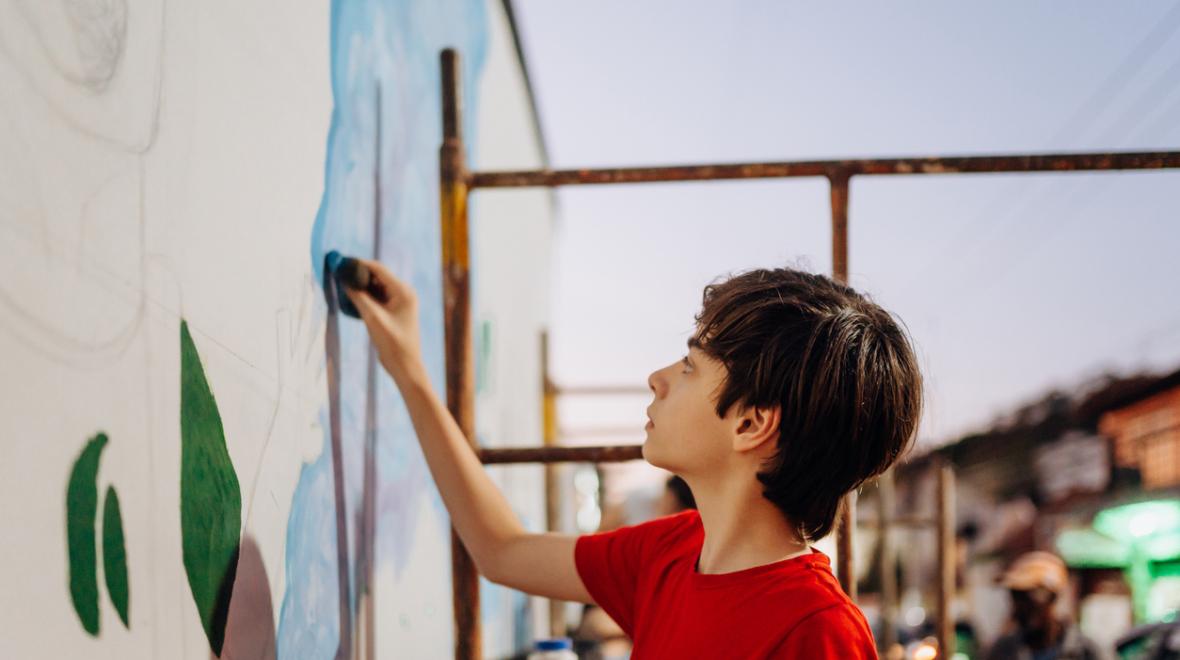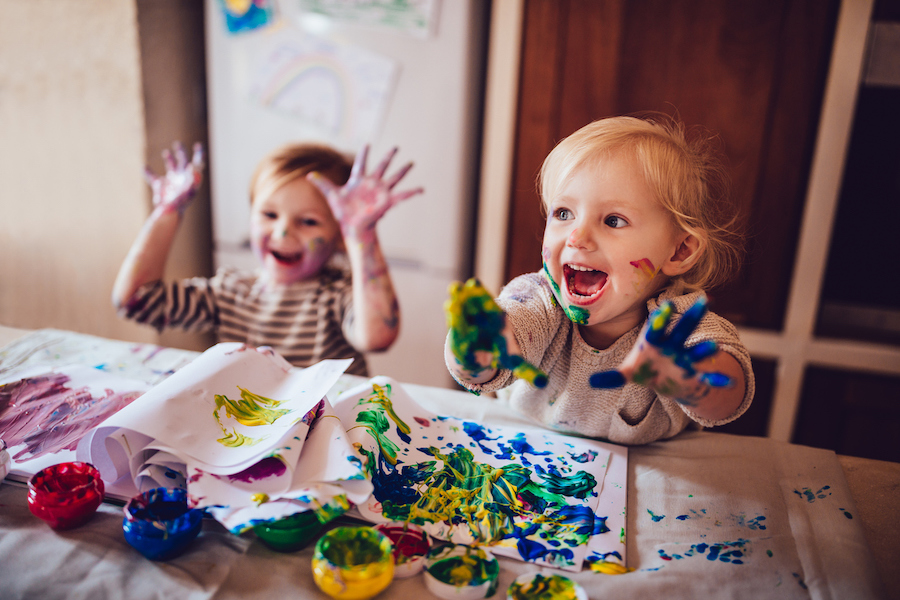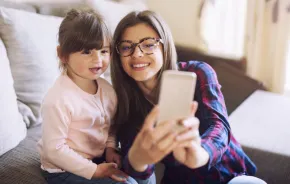
Photo:
iStock
Creativity might be defined as putting things together in novel ways, or seeing the world, or a given problem, with fresh eyes. While some people are born with talent in certain mediums — an artist’s eye, for instance, or perfect pitch, or a writer’s way with words — everyone has the capacity to be creative. All of us need access to our creativity to solve the problems of daily life, and all of us need to express our creativity to engage our whole selves and feel fully alive.
We can’t give people talent, but we can train the eye and the ear and the mind, and we can help our children gain access to a creative way of seeing. We can also help them gain the concentration, competence, perseverance and optimism necessary to succeed in creative pursuits.
Recent studies examining creativity have surprised researchers. The researchers began with the assumption that the kids recommended by their art teachers as being the most creative would be the “artist types” — kids who performed more poorly in other classes at school and tended to be more emotionally volatile and less organized. They were wrong.
High school art teachers named as most creative the same kids who excelled at getting their work done in other classes. These kids exhibited concentration during demonstrations of technique, the competence to plan their projects, the optimism to take the risk of tackling a more difficult or original idea, and the perseverance to put in the extra time required to do a thorough job completing the project. While this does not speak to talent, it highlights the point that putting creativity to use in the world requires the same qualities of competence addressed elsewhere on this website. It also implies that the same parenting that helps kids become emotionally healthy encourages creativity.

How do you help your child develop their creativity?
1. Neatness is over-rated.
Whether it’s because they’re afraid to get their hands dirty, or because they can’t leave their art supplies visible and easily accessible, or because they live by too many rules and don’t think outside the box, kids who live in households with a focus on neatness are rated as less creative. As Ms. Frizzle of “The Magic School Bus” says, “Take chances! Get messy!”
2. Children who experience frequent limits train themselves to think inside the box.
Babies should learn NO about safety issues, like a hot stove. But otherwise, you want them to see the world as full of possibilities. Why not let your baby empty the bookcase or the kitchen cabinet? Why shouldn’t your toddler “paint” the patio with a paintbrush and a pail of water?
3. Focus on play and process, not productivity.
When kids do art to solicit positive comments from adults, sometimes they can’t wait to finish another picture to get that “Good job!” But obviously, it isn’t about how many pictures they produce, it’s how engaged they are in the process. If you affirm how hard they’re working on that picture, they don’t have to rush through it to the next one to get your approval.
4. Give your child permission to be different.
Inventive, original kids are often seen as different by other kids. A little wacky, perhaps, or just plain odd. To develop their individuality, they need our support against the pressures of popular culture. Make it okay for your child to be out of step with the norms of their peer group, to be unique, to see the world through their own lens.
You’ll probably have to start by confronting your own fears about your child not being “popular.” Don’t worry, at the high school reunion, it’s commonplace to find that the nerd has become a self-made millionaire, and that odd, silent girl is now a famous novelist. It’s true that kids who are allowed to be themselves and express their unique take on the world may be seen as different by their peers, but that’s not a bad thing. They’re also often more creative and successful.
In fact, popularity is a risk factor for peer-pressure-related problems! As long as your child has a good friend or two, that’s actually healthier than being “popular.”
5. Let toddlers experiment with manageable messes.
Let toddlers experiment with manageable messes that they help clean up. Examples: water on the kitchen floor, bubbles on the porch, watercolors or chalk on the sidewalk (just get out the hose), food coloring in an unbreakable bowl with almost anything (snow, whipped cream, cornstarch or water). My daughter at age 4 loved breaking eggs to see what was inside; we occasionally let her smash them into a bowl.

6. Establish a place for art supplies.
Establish a place for art supplies early on, one that is both easily accessible and neat. It should include drawers or bins for washable markers, paper, clay and anything else you feel comfortable adding as your children get older (beads, collage materials, stamps and ink pads, etc.) Coloring books don’t exactly foster creativity; plain paper is much better. Blocks, with their infinite possibilities, generally offer more creative play opportunities than more sophisticated building materials. Many 4-year-olds can build with blocks for hours every day; it helps develop mathematical, spatial and problem-solving abilities.
7. Make creative art play easy.
If your child can initiate art activities without your help, they are more likely to create art when the spirit moves them. The best gift we ever received was a plastic tray for our daughter to put her paper in as she worked; a designated cookie sheet with a rim works just as well. (You’ll need one for each kid, and to wash them after messy projects.) Kids can do art with no worry, since crayon marks, glitter, play dough, etc. all have a contained space. You still need rules (“Play dough stays on the tray,” “Mom has to supervise pouring the glitter,” “We always put newspaper down when we paint!”), but creative arts become more a part of your child’s everyday life, as they become “theirs.”
8. Help your budding artist stay centered.
From Vincent van Gogh to Sylvia Plath, the stereotype of artists being mentally imbalanced pervades Western culture. It’s possible that these examples of talent paired with emotional disturbance are simply coincidence. It’s also possible that the agony of a painful childhood expresses itself best through art.
It’s conceivable that people who break with society to follow their own drummer are less likely to use the kinds of routines and conventions that keep most people anchored. And it may be possible, as some spiritual adepts say, that people who open themselves fully to the creative energy of the universe, without the emotional and spiritual maturity to handle it and without the guidance of a spiritual teacher, can be overwhelmed by the power that comes through them.
Kids who regularly use the TV or computer are more likely to feel bored than other kids, and even after eliminating the habit it can take months for them to find other activities about which they are passionate.
Regardless of the reasons for the association between creativity and mental health issues, it can be argued that creative people may well need extra help to learn how to stay centered. You can protect your budding artist by helping them develop supportive structures.
Some ideas: Be sure your child gets enough physical exercise to stay grounded. Help them regulate their body clock so they don’t stay up all night painting. Teach them to meditate. Promote a balanced diet sans caffeine. Introduce them to artists who have healthy, balanced lives, whether through biographies or movies — or in the flesh! Make sure you’re there when they want to talk.
And most important, introduce your child to the time-honored idea that creativity comes through us, not from us. The idea of the muse, of spirit looking for an artist to record that snatch of beauty to share with humanity, removes much of the stress of performance that can otherwise trap creative people. It also moderates the highs (which lead to arrogance) and lows (to fear, shame, self-doubt) that pervade the creative life. For a much better description of this process than I can offer, check out Liz Gilbert — author of “Eat, Pray, Love” — speaking about this issue in her TED Talk.
9. Don’t be afraid of boredom.
Parents often respond to kids’ boredom by providing structured activities or technological entertainment. But unstructured time challenges kids to engage with themselves and the world, to imagine and invent and create. Kids need practice with unstructured time or they will never learn to manage it.
Even more important, children need empty time to explore their inner and outer worlds, which is the beginning of creativity. So how to respond when kids complain that they’re bored? Help them brainstorm about possible activities, but make it clear that it’s their job to figure out how to enjoy their own time. (Learn more on handling boredom.)
A crucial tip: It helps enormously to prevent kids from depending on screens to entertain them. Kids who regularly use the TV or computer are more likely to feel bored than other kids, and even after eliminating the habit it can take months for them to find other activities about which they are passionate. But don’t despair. Just start cutting back on screens. Your child will object, but you’ll see a new engagement with their own creativity begin to develop.
10. Encourage kids to create together.
While we usually think of creativity as an individual pursuit, sometimes the most rewarding creative experiences come from people working together. The most creative and innovative organizations are known for encouraging teamwork, because the best ideas are often a product of collaboration. So, whether children are building with blocks or writing a story, it’s worth supporting them to work through the challenges inherent in creating with another person, because the experience can be transformative.
More resources for raising capable kids: |
Editor’s note: This article was originally published on Peaceful Parent, Happy Kids (previously called Aha! Parenting) and is republished here with permission. This article was updated in January 2025 by ParentMap’s editorial team with new formatting, photography and resources.











